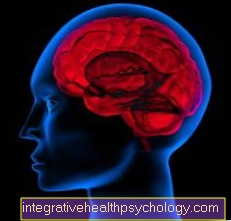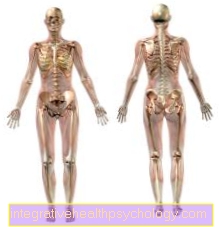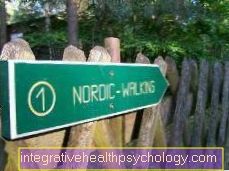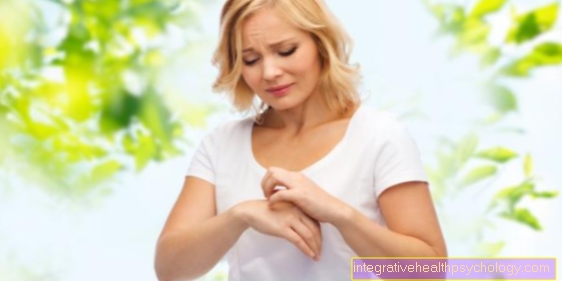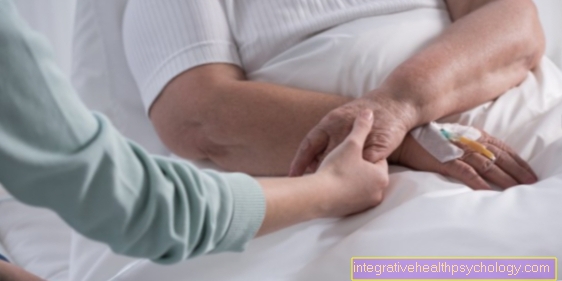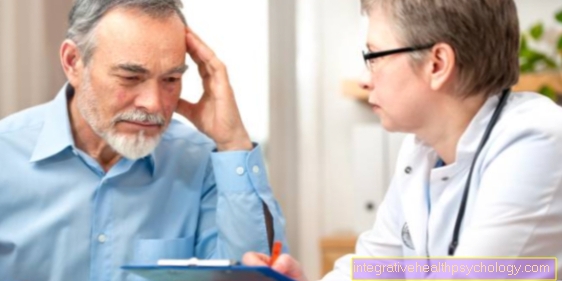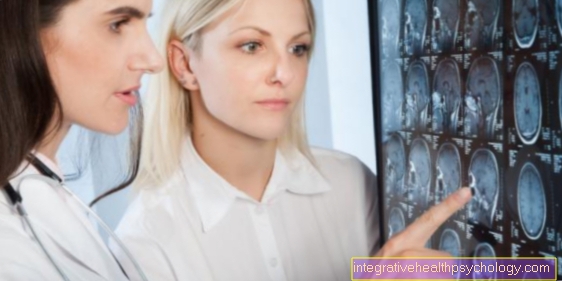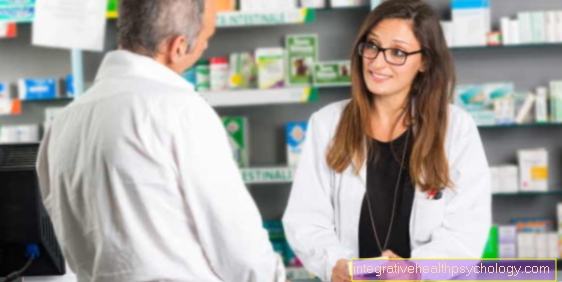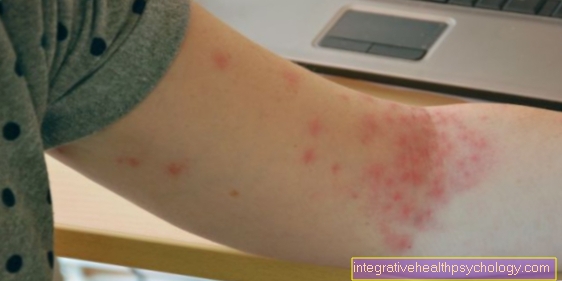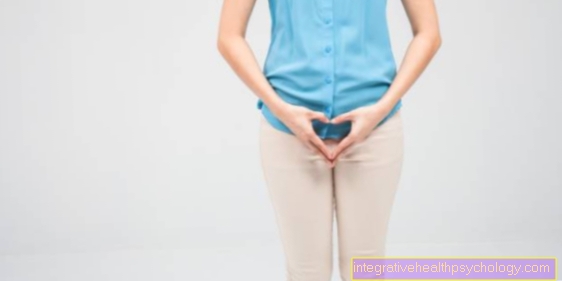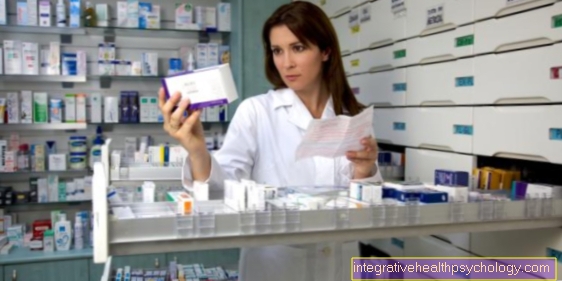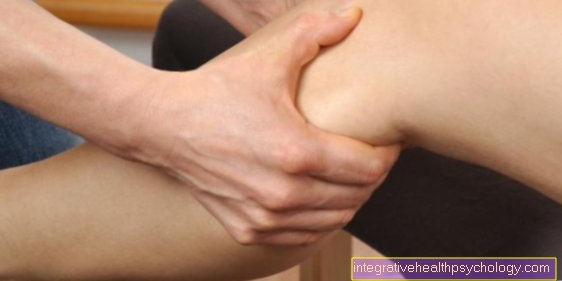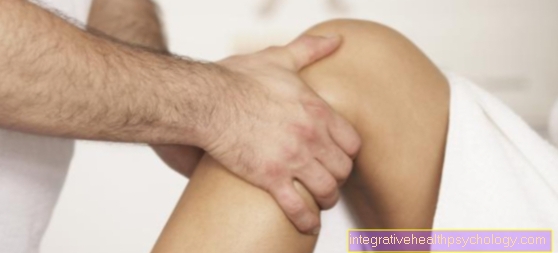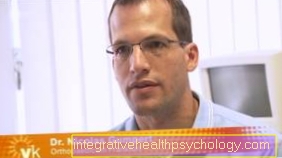Mastitis non puerperalis
definition
Mastitis non puerperalis is an inflammation of the breast that occurs outside of pregnancy and breastfeeding. It occurs about as often as its counterpart (mastitis pueperalis), which is an inflammation of the breast during breastfeeding. Mastitis non puerperalis can be caused by bacteria, but also without the influence of external germs. The inflammation is often found in the upper part of the outer breast. It manifests as pain, warmth, and swelling of the chest, but usually does not cause a fever. The therapy consists of cooling, nicotine abstinence and, in the case of a bacterial cause, antibiotic therapy.

causes
If mastitis non puerperalis develops due to bacterial inflammation, 40% of the germs are staphylococci. Often, however, there are mixed infections with different bacteria. Factors that promote bacterial inflammation are piercings, smoking, use of high-estrogen birth control pills, and a recent period of breastfeeding. Galactorrhea, a discharge of breast milk outside of the breastfeeding period, is still a common cause of the infection. However, mastitis non puerperalis can also develop without the influence of bacteria, for example in benign diseases of the breast, such as the secretion of breast milk outside of the breastfeeding period, premenstrual pain in the breast (mastodynia) or hormone-related remodeling processes in the breast (mastopathy). There is an increased secretion of breast milk or liquids similar to it. These accumulate within the milk ducts and milk is stored in the breast. The body recognizes this incorrect storage and triggers an inflammatory reaction and the symptoms described below occur.
diagnosis
The diagnosis is primarily made on the basis of the clinical examination. The breast is systematically palpated with both hands and in the case of mastitis non puerperalis one can feel coarse, hardened tissue that can be easily distinguished from normal tissue.
The hardening is caused on the one hand by the causal storage of the milk and the resulting inflammation with inflammatory edema. Sonography (ultrasound) can be used to rule out an abscess, i.e. an encapsulated collection of pus. This is shown in the ultrasound image with a blurred definition and with different echogenicity (recognizable in the image by different gray levels). Ultrasound is not suitable for viewing the inflammation in the tissue.
Concomitant symptoms
Mastitis non puerperalis shows the classic signs of inflammation. The most noticeable of these are overheating of the breast, which can be clearly felt in a side comparison, and reddening of the inflamed areas. There is also often pronounced swelling of the chest, some of which can be painful. In the inflamed area, the chest may feel hard and painful to the touch. A pain in the nipple area can also indicate non puerperal mastitis. In 50% of patients, there is also a swelling of the lymph nodes in the armpit on the side of the inflamed breast.
fever
In contrast to puerperal mastitis, mastitits non puerperalis only very rarely results in a fever.
chills
Chills are also typical of mastitis during breastfeeding, but not of non puerperal mastitis.
Treatment / therapy
In addition to a specific therapy, smoking cessation during the inflammatory phase is one of the most important approaches of treatment. Cooling the compresses can be helpful against swelling and overheating, but excessive cooling should not be used to avoid circulatory reactions or local damage caused by the cold. Anti-inflammatory drugs such as ibuprofen can be taken against the pain, as these also have a positive effect on the inflammatory processes.
If mastitis non puerperalis is caused by a bacterial infection, an antibiotic should be taken in addition to the anti-inflammatory measures. Either a combination of a cephalosporin and metronidazole or clindamycin is suitable for this.
If the cause of the mastitis is increased milk production without bacterial inflammation and there is still no abscess, a dopamine agonist such as bromocriptine can be given for a few days, which downregulates milk production and thus relieves the breast. Many patients report that they are symptom-free after just 2-4 days. After completing therapy, prophylactic mammography should be performed, as inflammatory breast cancer is one of the most important differential diagnoses.
Home remedies
Especially with local therapy, some home remedies can help alleviate the symptoms.
Quark wraps, wraps with natural honey or compresses with vinegar-acidified clay can be used to cool the affected area. A white cabbage leaf in the bra can also create a pleasant cooling effect and the leaves also work on a second level by helping to lift the congestion in the milk ducts, which in most cases is the cause of mastitis.
Local application of hot water can also help clear the milk ducts. Hot showers are therefore recommended as a home remedy for mastitis as they also relieve the pain. In addition to local applications, home remedies can also have a positive impact on milk production. Drinking at least two cups of hibiscus, peppermint or sage tea a day can reduce milk production. In addition to these specific therapeutic approaches, it is essential to get enough rest and sleep during acute mastitis so that the body can activate its natural defenses in the best possible way.
Homeopathy
Belladonna 6X can be taken in the first phase of inflammation with local pain and heat development. If no abscess formation is observed, Clematis recta D6 can be used in the course of the inflammation in the case of swollen lymph nodes, which is particularly indicated in the subacute course.
In the event of an abscess, Hepar sulfuris D12 can bring about faster wound healing of the open tissue after the puncture and drainage.
As a universal wound healing agent, arnica can also have an effect on pain and swelling in the early stages.
Read more about this at: Homeopathy for breast inflammation
When do i need an antibiotic?
An antibiotic should always be prescribed when bacterial mastitis is involved. Depending on the antibiotic, this must be taken between 2-10 days. In most cases, this results in rapid healing of the mastitis non puerperalis.
When do I have to wean?
Since mastitis non puerperalis by definition does not occur during the breastfeeding period, the question of weaning has no further relevance.
However, if puerperal mastitis is present, which according to the definition occurs during breastfeeding, breastfeeding is only required in rare cases; for example, premature babies should not be breastfed if they have bacterial mastitis and if they are infected with group B streptococci, breastfeeding should not continue.
You can find more information here: Inflammation of the mammary gland during breastfeeding
What are the dangers for my baby?
Here, too, it should be said that mastitis non puerperalis does not occur during the breastfeeding period, so that the dangers that exist during breastfeeding are not an issue here. Contact transfer has not yet been described in the medical literature. If there is an abscess, it is still advisable for mother and child to bandage open areas, for example, when draining the abscess, until they have healed.
Duration
Both antibiotic therapy and therapy with prolactin inhibitors in the case of an abacterial course show an effect quickly and the patient is symptom-free after a few days. However, a sufficiently long drug therapy is important, otherwise the risk of recurrence is high, and further inflammation is more likely to lead to the development of a breast abscess and the risk of becoming chronic. If an abscess is already present, the healing time is also extended, as the damaged tissue needs time for the wound to heal and regenerate after the abscess has been drained.
Breast abscess
If mastitis non puerperalis is treated too late, a capsule can form around the inflammation, which then develops into an abscess.
An abscess is always filled with pus. The abscess can be felt as a very painful but movable lump in the breast. Since a breast abscess only rarely heals on its own, it usually has to be pierced with a needle and emptied. If more abscesses develop after the first abscess has been drained, an open operation may have to be performed to remove the entire capsule of the abscess and thoroughly clean the remaining tissue.
As a prophylaxis against further abscesses, it is advisable in some cases to take a prolactin inhibitor for 3-6 weeks.
Read more about this at: Breast abscess
More interesting information
Other topics that might interest you:
- Diseases of the female breast
- Puerperal mastitis
- Breast abscess
- Breast cancer
- Inflammation of the nipple
- Galactorrhea
- Male chest
You can find an overview of all gynecological topics under: Gynecology A-Z



